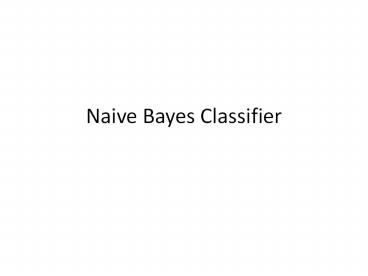Naive Bayes Classifier PowerPoint PPT Presentation
Title: Naive Bayes Classifier
1
Naive Bayes Classifier
2
REVIEW Bayesian Methods
- Our focus this lecture
- Learning and classification methods based on
probability theory. - Bayes theorem plays a critical role in
probabilistic learning and classification. - Bayes theorem uses prior probability of each
category given no information about an item. - Categorization produces a posterior probability
distribution over the possible categories given a
description of an item. - Example tennis playing last lecture
3
In these reasonings we use the Basic Probability
Formulas
- Product rule
- Sum rule
- Bayes theorem
- Theorem of total probability, if event Ai is
mutually exclusive and probability sum to 1
4
REVIEW AND TERMINOLOGY Bayes Theorem
- Given a hypothesis h and data D which bears on
the hypothesis - P(h) independent probability of h prior
probability - P(D) independent probability of D
- P(Dh) conditional probability of D given h
likelihood - P(hD) conditional probability of h given D
posterior probability
5
Possible problem to solve using this method Does
patient have cancer or not?
- A patient takes a lab test and the result comes
back positive. - It is known that the test returns a correct
positive result in only 99 of the cases and a
correct negative result in only 95 of the cases. - Furthermore, only 0.03 of the entire population
has this disease. - 1. What is the probability that this patient has
cancer? - 2. What is the probability that he does not have
cancer? - 3. What is the diagnosis?
- The same applies to the door open, door closed
example of a robot on corridor few lectures
earlier. - The same is true in any conditional probability
reasoning.
6
Maximum A Posterior
- Based on Bayes Theorem, we can compute the
Maximum A Posterior (MAP) hypothesis for the data - We are interested in the best hypothesis for some
space H given observed training data D.
H set of all hypothesis. Note that we can drop
P(D) as the probability of the data is constant
(and independent of the hypothesis).
We gave an example of MAP in last set of slides
in tennis example
7
Maximum Likelihood Hypothesis
- Now assume that all hypotheses are equally
probable a priori, i.e., P(hi ) P(hj ) for all
hi, hj belong to H. - This is called assuming a uniform prior.
- It simplifies computing the posterior
- This hypothesis is called the maximum likelihood
hypothesis.
8
Desirable Properties of Bayes Classifier
9
Desirable Properties of Bayes Classifier
- Incrementality with each training example, the
prior and the likelihood can be updated
dynamically flexible and robust to errors. - Combines prior knowledge and observed data prior
probability of a hypothesis multiplied with
probability of the hypothesis given the training
data - Probabilistic hypothesis outputs not only a
classification, but a probability distribution
over all classes
Again refer to tennis example
10
Characteristics of Bayes Classifiers
Assumption training set consists of instances of
different classes described cj as conjunctions of
attributes values Task Classify a new instance d
based on a tuple of attribute values into one
of the classes cj ? C Key idea assign the most
probable class using Bayes Theorem.
11
Parameters estimation in Naïve Bayes
- P(cj)
- Can be estimated from the frequency of classes in
the training examples. - P(x1,x2,,xncj)
- O(XnC) is the number of parameters
- This probability could only be estimated if a
very, very large number of training examples was
available. - Independence Assumption attribute values are
conditionally independent given the target value
naïve Bayes.
12
Properties of Naïve Bayes
13
Properties of Naïve Bayes
- Estimating instead of
greatly reduces the number of
parameters (and the data sparseness). - The learning step in Naïve Bayes consists of
estimating and based on the
frequencies in the training data - An unseen instance is classified by computing the
class that maximizes the posterior - When conditioned independence is satisfied, Naïve
Bayes corresponds to MAP classification.
14
Reminder Example. Play Tennis data
Question For the day ltsunny, cool, high,
stronggt, whats the play prediction?
15
Naive Bayes solution
- Classify any new datum instance x(a1,aT) as
- To do this based on training examples, we need to
estimate the parameters from the training
examples - For each target value (hypothesis) h
- For each attribute value at of each datum
instance
16
- Based on the examples in the table, classify the
following datum x - x(OutlSunny, TempCool, HumHigh, Windstrong)
- That means Play tennis or not?
- Working
17
Underflow Prevention
- Multiplying lots of probabilities, which are
between 0 and 1 by definition, can result in
floating-point underflow. - Since log(xy) log(x) log(y), it is better to
perform all computations by summing logs of
probabilities rather than multiplying
probabilities. - Class with highest final un-normalized log
probability score is still the most probable.

